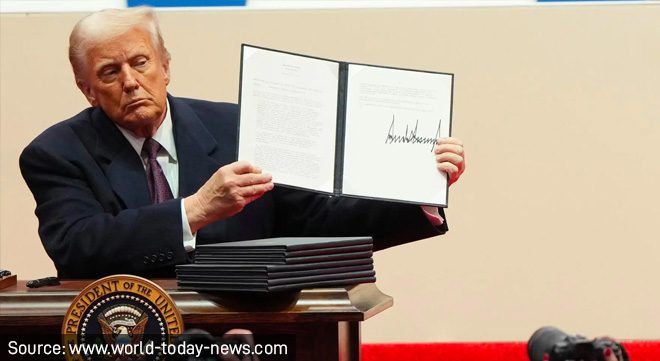As we navigate the economic uncertainties of the year ahead, investors face a whirlwind of headlines and predictions. With Donald Trump beginning his second term as United States president, his administration’s policies are already sparking debate and speculation about their impact on the global economy.
Izak Odendaal, the chief investment strategist at Old Mutual Wealth, says staying focused on two fundamental issues will help investors to make informed decisions while tuning out distractions. These issues are the risk of a US recession and the possibility that the Federal Reserve will hike interest rates again.
Risk of a US recession
The US economy enters the year on solid footing. Growth rates in activity, sales, income, and employment remain robust. Corporate profitability is healthy, and private balance sheets are strong. These factors make a near-term recession unlikely, Odendaal says.
Growth is naturally expected to slow from its current elevated levels. The question is whether Trump’s policies could accelerate the slowdown.
Odendaal says introducing steep import tariffs across the board could be incredibly disruptive, particularly if other countries respond with tit-for-tat tariff increases. That said, many investors believe the threat of tariffs is more rhetoric than reality, aimed at negotiating better terms rather than fundamentally altering trade structures.
He says if the tariff increases are narrow, targeted, and not too high, the impact on US and global growth is unlikely to be significant, although specific sectors will be hit.
As for the other elements of the Trump agenda, it is also still too soon to know.
“Much emphasis has been placed on deregulation as a means of spurring growth, but the US is already less regulated than most other advanced economies. The boost from deregulation is not as big as might be expected,” Odendaal says.
He says it is hard to envisage US oil production surging from current levels, because it is already at a record high of 13 million barrels per day. Trump promised lower fuel prices through increased production, but prices will need to be higher to incentivise more output.
As for tax cuts, he says the 2017 tax cut package that favoured companies and the wealthy, was due to expire at the end of the year. It will be made permanent.
However, Odendaal says additional tax relief will be needed to deliver a positive growth boost.
Team Trump argues that additional relief can be funded by tariffs: as the US government gets more revenue from import taxes, it can reduce income taxes. However, this seems unlikely. The point of tariffs is principally to discourage imports and encourage local production, not to raise revenue, Odendaal says.
A century or more ago, tariffs were a major source of government funding, but the government was much smaller then. “Therefore, tax cuts will either raise the deficit, which some Republicans will baulk at, or require spending cuts, which is always politically unpopular, so other Republicans in Congress could object to it.”
Although the Republicans won a decisive victory in November, they have only a five-seat majority in the House of Representatives, and a handful of defectors could scupper any proposed legislation.
Possibility of Federal Reserve hikes
Odendaal says the Fed will have to resume hiking if inflation moves away from the Fed’s 2% target, rather than moving gradually towards it, as is the case currently.
Market pricing for where the Fed funds rate will land has moved around wildly over the past year. Pricing for end-2025 hit a high of 4.5% and a low of 2.6% (currently at 3.9%), so Odendaal says investors should be wary of those who say they know with confidence where rates will settle. That said, pricing has consistently been that rates will be lower than where they are now.
What could drive inflation higher? Additional economic boosts from Trump’s policies or labour shortages from stricter immigration rules could contribute. Likewise, tariffs might cause one-off price increases.
Odendaal says this scenario still seems unlikely.
“Tariffs, for instance, are not inflationary by themselves. They cause one-off price jumps, not necessarily ongoing price increases. The latter will really depend on the prevailing economic conditions and whether companies feel they have pricing power. In 2022, they did, and higher input costs due to supply-chain disruptions and higher commodity prices were passed on to consumers in the US and across the globe. Company margins expanded.
“A strong dollar could also counteract the impact of tariffs. Indeed, the strong dollar presents something of a dilemma to the incoming administration. If you want to encourage domestic production and reduce imports, the last thing you want is a strong currency.”
Odendaal says it will also be important for the Fed whether inflation expectations remain anchored. If people believe price movements are temporary, they are unlikely to change their economic behaviour. But if they believe that prices will rise more than 2% annually, it could become self-fulfilling.
One survey shows that people who identify as Democrats believe inflation will be much higher under Trump, whereas Republicans believe it will be much lower. “This politicised split in outlook makes consumer confidence surveys much less useful as an indicator than in the past.”
Other indicators of inflation expectations, such as those expressed in the bond market, have not risen much.
Recent labour market and inflation data limit the case for Fed rate cuts over the next few months. However, if growth cools during the course of the year, the Fed is likely to resume lowering rates, Odendaal says.
In the meantime, market-based long-term interest rates (bond yields) have increased in recent weeks even as central banks have been cutting short-term rates. This hurts households through higher mortgage rates and companies through higher corporate bond yields and is therefore one of the factors that will dampen growth this year. However, neither mortgage rates nor corporate bond yields have broken through the trading range of the past three years.
The case for staying calm
Investors often feel pressured to act in the face of uncertainty, but, as Odendaal points out, reacting to short-term market volatility often does more harm than good.
In his view, the best strategy for investors with diversified portfolios and long-term investment horizons may be to stay the course. The US economy is resilient, and global markets have weathered challenges far more significant than the headlines of the moment.
The key is to focus on the fundamentals. Although there will be plenty of noise – from political developments to market swings – most of it will have little lasting impact on your financial future. By concentrating on core issues such as recession risk and Fed policy, you can avoid becoming sidetracked and make smarter investment decisions.
Odendaal reminds investors that doing nothing can often be the most prudent action. Resisting the urge to react to every market fluctuation or sensational headline requires discipline but can yield better outcomes over time. If your portfolio is well balanced and aligned with your financial goals, let time and compounding work their magic.
Disclaimer: The information in this article does not constitute investment or financial planning advice that is appropriate for every individual’s needs and circumstances.



